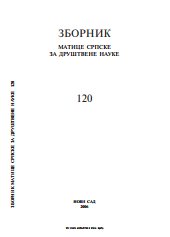СРБИ У ХРВАТСКОЈ ПРЕ И ПОСЛЕ РАСПАДА ЈУГОСЛАВИЈЕ
THE SERBS IN CROATIA BEFORE AND AFTER THE BREAK-UP OF YUGOSLAVIA
Author(s): Jovan IlićSubject(s): Geography, Regional studies, Recent History (1900 till today), Inter-Ethnic Relations, Identity of Collectives
Published by: Матица српска
Keywords: Croats; Republic of Croatia; Republic of Srpska Krajina; Serb refugees and banished;
Summary/Abstract: The Serbs are first mentioned in the west part of the Balkan peninsula in 822. They populated the regions east of the river Cetina, mountain Plješevica and the area between the rivers Una and Kupa. It means that the significant part of the present Republic of Croatia had been populated by the Serbs since the settlement of the Slavs. The main regions mostly populated by the Serbs were north-west Dalmatia, the larger part of Lika and Kordun, Banija, west Slavonia and smaller sections in east Slavonia, west Srem and Baranya. Social-political circumstances for the life of the Serbs in Croatia were mostly very unfavourable. Extremely unfavourable circumstances were during World War II in The Independent State of Croatia, when the Croatian ustasha fighters carried out an extensive, systematic, comprehensive and bestial genocide, that is ethnocide over the Serbs. The second genocide, that is ethnocide over the Serbs in Croatia was carried out in the civil ethnic-religious war 1991—1995, specially in 1995. In these years, the nationalist-chauvinist, antiserbian movement and war suddenly flared up in Croatia. The Serbs living there were forced to defend, so on December 19, 1991 they proclaimed The Republic of Srpska Krajina. However, the Croatian armed forces were military stronger. The Serbs were defeated and punished by the total destruction of their property and mass expulsion. In that cruel civil-ethnic war, about 276.000 Serbs were expelled from Croatia, several thousand of them were killed. About 40.000 Serbian houses were destroyed and 380 Serbian villages were burnt. Hundreds of Serbian-Orthodox religious edifices were burnt or destroyed. The value of the destroyed or plundered Serbian property in Croatia was estimated at about 30 billion euros. According to the official Croatian data, in the last several years about 60.000 Serbs-refugees returned from Serbia to their native land, mostly older persons or those who returned to sell their property and leave Croatia again. About 40.000 of them went to live abroad. However, the Serbs-returnees still live in very difficult conditions, discriminated in all segments of life, primarily when it comes to employment.
Journal: Зборник Матице српске за друштвене науке
- Issue Year: 2006
- Issue No: 120
- Page Range: 253-270
- Page Count: 18
- Language: Serbian

